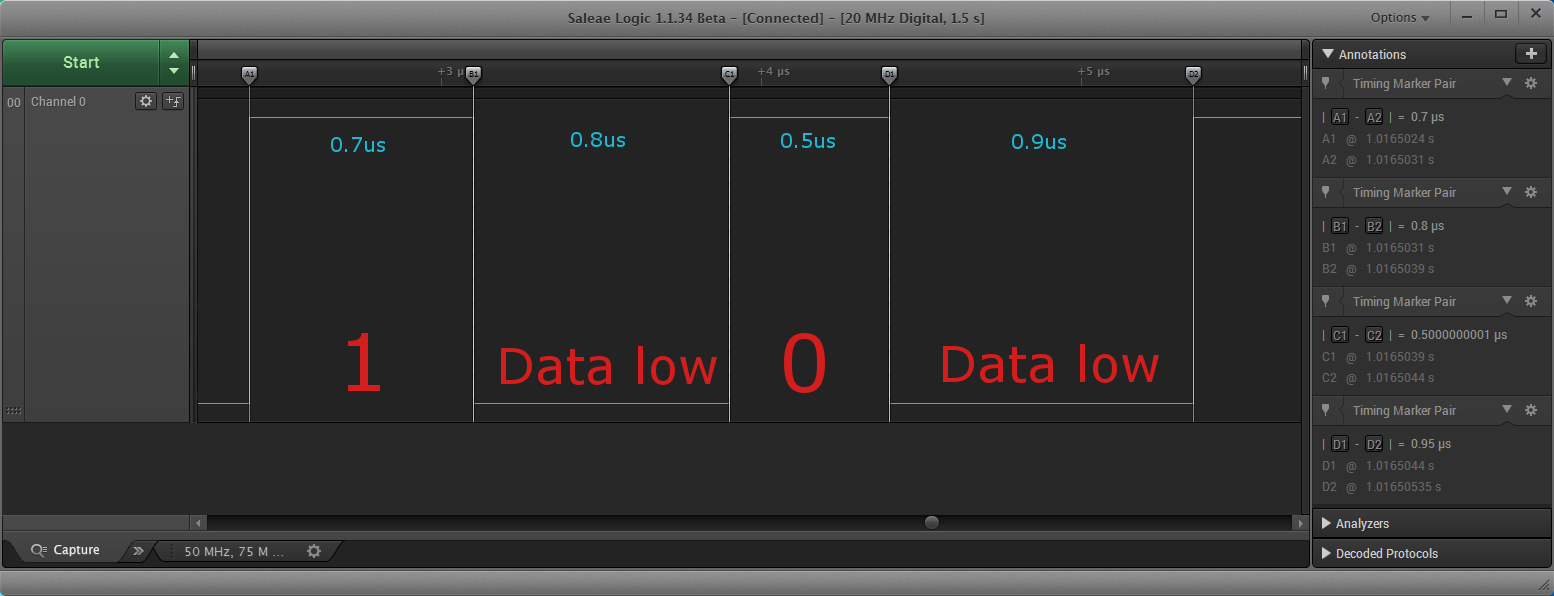Library for the WS2812 LED Driver. Uses bit banging and nops for precise timing. Number of nops executed are configurable at run time.
Dependents: WS2812_Example WS2812_Example_fade Lamp_03 Lamp_04 ... more
This library uses bit banging to control the LED strip. Because the mbed platform doesn't have a timer standardized that doesn't have a resolution lower a microsecond, we have to use NOPs. Also, the time it takes to toggle a GPIO pin is not consistent across platforms and it does not correlate to the system clock in any way. It is completely dependent on the platform's implementation.
I have a found the timings for a few boards. They are currently listed on the example program page below.
Import programWS2812_Example
Example for WS2812 Library
When using this on a new platform, you'll need to use a logic analyzer to determine the timings.

Above is a screenshot from a Saleae logic analyzer. You'll notice that the "1" pulse is longer than the "0" pulse. The "Data low" pulses should be consistent. The timing requirements for these pulses can be found below (Source: http://wp.josh.com/2014/05/13/ws2812-neopixels-are-not-so-finicky-once-you-get-to-know-them/).

If you find timings for a new board you're using, please PM me or start a discussion below and I'll add it to this page!
For more on the timings and data format of the WS2812 drivers, you should read the datasheet and the article "NeoPixels Revealed: How to (not need to) generate precisely timed signals" listed below.
References:
WS2812B Datasheet: https://www.adafruit.com/datasheets/WS2812B.pdf
"NeoPixels Revealed: How to (not need to) generate precisely timed signals": http://wp.josh.com/2014/05/13/ws2812-neopixels-are-not-so-finicky-once-you-get-to-know-them/
Diff: WS2812.h
- Revision:
- 1:aadbf08c62a2
- Parent:
- 0:0b79cafcb387
- Child:
- 2:6e647820f587
--- a/WS2812.h Thu Feb 12 19:17:10 2015 +0000
+++ b/WS2812.h Thu Feb 12 20:20:10 2015 +0000
@@ -21,12 +21,8 @@
#include "mbed.h"
-#define WS1 0x38
-#define WS0 0x30
-#define SPICLK 5000000
#define FRAME_SIZE 24
-
//!Library for the WS2812 RGB LED with integrated controller
/*!
The WS2812 is controller that is built into a range of LEDs
@@ -34,23 +30,71 @@
class WS2812
{
public:
- //!Creates an instance of the class.
- /*!
- Connect WS2812 address addr using digital pins
+ enum BrightnessControl { OFF, GLOBAL, PER_PIXEL };
+
+ /**
+ * Constructor
+ *
+ * @param pin Output pin. Connect to "Din" on the first WS2812 in the strip
+ * @param size Number of LEDs in your strip
+ * @param zeroHigh How many NOPs to insert to ensure TOH is properly generated. See library description for more information.
+ * @param zeroLow How many NOPs to insert to ensure TOL is properly generated. See library description for more information.
+ * @param oneHigh How many NOPs to insert to ensure T1H is properly generated. See library description for more information.
+ * @param oneLow How many NOPs to insert to ensure T1L is properly generated. See library description for more information.
+ *
*/
- WS2812(PinName d, int size);
+ WS2812(PinName pin, int size, int zeroHigh, int zeroLow, int oneHigh, int oneLow);
/*!
Destroys instance.
*/
~WS2812();
+ /**
+ * Sets the timing parameters for the bit-banged signal
+ *
+ * @param zeroHigh How many NOPs to insert to ensure TOH is properly generated. See library description for more information.
+ * @param zeroLow How many NOPs to insert to ensure TOL is properly generated. See library description for more information.
+ * @param oneHigh How many NOPs to insert to ensure T1H is properly generated. See library description for more information.
+ * @param oneLow How many NOPs to insert to ensure T1L is properly generated. See library description for more information.
+ *
+ */
void setDelays(int zeroHigh, int zeroLow, int oneHigh, int oneLow);
+ /**
+ * Sets the timing parameters for the bit-banged signal
+ *
+ * @param buf Pointer to the PixelArray buffer
+ * @param r_offset The offset where each each pixel pulls its red component. Wraps to beginning if end is reached.
+ * @param g_offset The offset where each each pixel pulls its green component. Wraps to beginning if end is reached.
+ * @param b_offset The offset where each each pixel pulls its blue component. Wraps to beginning if end is reached.
+ *
+ */
+ void write_offsets(int buf[], int r_offset = 0, int g_offset = 0, int b_offset = 0);
+
+
+ /**
+ * Write the given buffer to the LED strip
+ *
+ * @param buf Pointer to the PixelArray buffer
+ *
+ */
void write(int buf[]);
- void write_offsets(int buf[],int r_offset=0, int g_offset=0, int b_offset=0);
-
- void useII(int d);
+
+ /**
+ * Sets the brightness mode
+ *
+ * @param bc The brightness control. Defaults to OFF. Possible values include OFF, GLOBAL, and PER_PIXEL
+ *
+ */
+ void useII(BrightnessControl bc);
+
+ /**
+ * Sets the global brightness level.
+ *
+ * @param II The brightness level. Possible values include 0 - 255 (0x00 - 0xFF).
+ *
+ */
void setII(unsigned char II);
@@ -60,7 +104,7 @@
int __size;
int __zeroHigh, __zeroLow, __oneHigh, __oneLow;
unsigned char __II;
- int __use_II;
+ BrightnessControl __use_II;
bool *__transmitBuf;
void __loadBuf(int buf[],int r_offset=0, int g_offset=0, int b_offset=0);
PinName __outPin;

 Generic WS2812 Driver
Generic WS2812 Driver